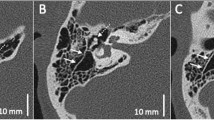Abstract
Purpose
Homogeneous development of temporal bone structures is explained by their ontogenic origin; tegmen tympani (TT) and superior semicircular canal (SSC) are related with the glenoid fossa at the temporomandibular joint (TMJ). Therefore, our objective was to determine a possible relationship between TT status (dehiscence or integrity) and the roof of the glenoid fossa (RGF) thickness; SSC status has also been considered.
Methods
This cross-sectional descriptive study was conducted in two tertiary hospitals on 95 patients (109 ears) presenting hypoacusia, facial palsy, vertigo, tinnitus, and other single or combined symptoms, and submitted to a thin-section multidetector-row computed axial tomography (CT) scan.
Results
A significant interaction effect of TT × SSC statuses on RGF thickness was found (p = 0.049). A significant difference in RGF thickness was found only for SSC integrity status between TT integrity and TT dehiscence (p = 0.004). The TT dehiscence increased the risk for RGF dehiscence 12.047 times (p = 0.002).
Conclusions
There is an interaction effect of the statuses of both TT and SSC on the thickness of the RGF, instead of an independent effect of the TT status. When RGF dehiscence is found, TT and SSC statuses should be assessed, to discard associated dehiscences.

Similar content being viewed by others
References
Crovetto-Martinez R, Vargas C, Lecumberri I, Bilbao A, Crovetto M, Whyte J (2018) Radiologic correlation between the thickness of the roof of the glenoid fossa and that of the bony covering of the superior semicircular canal. Oral Surg Oral Med Oral Pathol Oral Radiol 125:358–363. https://doi.org/10.1016/j.oooo.2017.12.008
De Jong MA, Carpenter DJ, Kaylie DM, Piker EG, Frank-Ito DO (2017) Temporal bone anatomy characteristics in superior semicircular canal dehiscence. J Otol 12:185–191. https://doi.org/10.1016/j.joto.2017.08.003
Friedland DR, Michel MA (2006) Cranial thickness in superior canal dehiscence syndrome: implications for canal resurfacing surgery. Otol Neurotol 27:346–354
Honda K, Kawashima S, Kashima M, Sawada K, Shinoda K, Sugisaki M (2005) Relationship between sex, age, and the minimum thickness of the roof of the glenoid fossa in normal temporomandibular joints. Clin Anat 18:23–26. https://doi.org/10.1002/ca.20054
Horna J, Gamboa J, Jorda JV, Olaizola F (1990) Embriología del oído. In: Olaizola F (ed) Malformaciones genéticas del oído y su tratamiento. Garsi, Madrid, pp 19–30
Iversen GR, Norpoth H (1987) Analysis of variance. Sage Publications Inc, UK
Kijima N, Honda K, Kuroki Y, Sakabe J, Ejima K, Nakajima I (2007) Relationship between patient characteristics, mandibular head morphology and thickness of the roof of the glenoid fossa in symptomatic temporomandibular joints. Dentomaxillofac Radiol 36:277–281. https://doi.org/10.1259/dmfr/56344782
Kurt H, Orhan K, Aksoy S, Kursun S, Akbulut N, Bilecenoglu B (2014) Evaluation of the superior semicircular canal morphology using cone beam computed tomography: a possible correlation for temporomandibular Joint symptpms. Oral Surg Oral Med Oral Pathol Oral Radiol 117:280–288. https://doi.org/10.1016/j.oooo.2014.01.011
Matsumoto K, Honda K, Sawada K, Tomita T, Araki M (2006) The thickness of the roof of the glenoid fossa in the temporomandibular joint: relationship to the MRI findings. Dentomaxillofac Radiol 35:357–364. https://doi.org/10.1259/dmfr/30011413
Menard S (2010) Logistic regression: from introductory to advanced concepts and applications. SAGE Publications Inc, UK
Mérida-Velasco JR, Rodríguez-Vázquez FJ, Mérida-Velasco JA, Sánchez-Montesinos I, Espin-Ferra J, Jiménez-Collado J (1999) Development of the human temporomandibular joint. Anat Rec 255:120–133. https://doi.org/10.1002/(sici)1097-0185(19990501)255:1%3c20:aid-ar4%3e3.0.co;2-n
Park JH, Kang SI, Choi HS, Lee SY, Kim JS, Koo JW (2015) Thickness of the bony otic capsule: etiopathogenetic perspectives on superior canal dehiscence syndrome. Audiol Neuro Otol 20:243–250. https://doi.org/10.1159/000371810
Richardson JTE (2011) Eta squared and partial eta squared as measures of effect size in educational research. Educ Res Rev 6:135–147. https://doi.org/10.1016/j.edurev.2010.12.001
Rizk HG, Hatch JL, Stevens SM, Lampert PR, Meyer TA (2006) Lateral skull base attenuation in superior semicircular canal dehiscence and spontaneous cerebrospinal fluid otorrhea. Otolaryngol Head Neck Surg 155:641–648. https://doi.org/10.1177/0194599816651261
Rodriguez-Vazquez JF, Murakami G, Verdugo-Lopez S, Abe SI, Fujimiya M (2011) Closure of the middle ear with special reference to the development of the tegmen tympani of the temporal bone. J Anat 218:690–698. https://doi.org/10.1111/j.1469-7580.2011.01378.x
Tóth M, Helling K, Baska G, Mann W (2007) Localization of congenital tegmen tympani defects. Otol Neurotol 28:1120–1123
Tsuruta A, Yamada K, Hanada K, Hosogai A, Tanaka R, Koyama J, Hayashi T (2003) Thickness of the roof of the glenoid fossa and condylar bone change: a CT study. Dentomaxillofac Radiol 32:217–221. https://doi.org/10.1259/dmfr/15476586
Whyte J, Tejedor MT, Fraile JJ, Cisneros A, Crovetto R, Monteagudo LV, Whyte A, Crovetto MA (2016) Association between tegmen tympani status and superior semicircular canal pattern. Otol Neurotol 37:66–69. https://doi.org/10.1097/MAO.0000000000000918
Funding
No funding.
Author information
Authors and Affiliations
Contributions
Protocol/project development: JW, AIC, MAC. Data collection and management: JW, JJF, MAC, RC, AW, LVM. Data analysis: JW, MTT. Manuscript writing/edition: JW, AIC, JJF, AW,RC, LVM, MAC, MTT.
Corresponding author
Ethics declarations
Conflict of interest
The authors declare that they have no conflict of interest.
Research involving human participants
The present study was performed following the guidelines of the Helsinki Declaration of 1983. All procedures performed in studies involving human participants were in accordance with the ethical standards of the institutional research committees.
Informed consent
A signed informed consent was obtained from every participating patient, and patients were completely anonymized by researchers. All authors ensure that submissions are HIPAA-compliant. Researchers followed every mandatory (health and safety) procedures.
Additional information
Publisher's Note
Springer Nature remains neutral with regard to jurisdictional claims in published maps and institutional affiliations.
Rights and permissions
About this article
Cite this article
Whyte, J., Cisneros, A.I., Fraile, J.J. et al. Interaction effect of tegmen tympani and superior semicircular canal statuses on the thickness of the roof of the glenoid fossa: a cross-sectional descriptive study. Surg Radiol Anat 42, 75–80 (2020). https://doi.org/10.1007/s00276-019-02358-w
Received:
Accepted:
Published:
Issue Date:
DOI: https://doi.org/10.1007/s00276-019-02358-w




